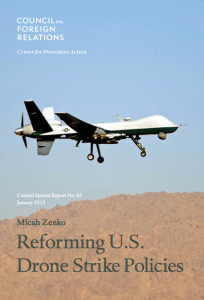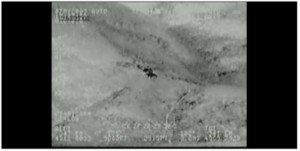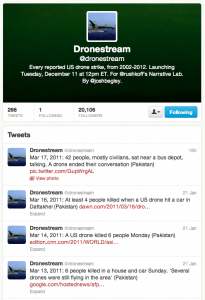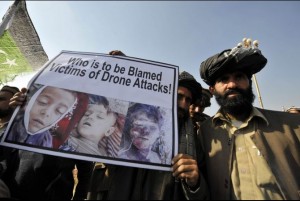Centre for Advanced International Theory (CAST), Department of Politics, University of Copenhagen
In the award-winning film Five-Thousand Feet is the Best (2011), video artist Omar Fast offers us, the viewers, his drone imaginary. Weaving testimony from a former US military Predator drone operator together with a fictionalized interview, a series of sequences acted on the ground, and the corresponding view from 5,000 feet above, Fast brings to the fore and ‘over here’ some of the troubling politics that have prompted so much discussion around the growing use of drones (also referred to as unmanned aerial vehicles or remotely piloted aircraft). Is it ethical to watch and then kill from ‘five thousand feet’? What is the effect of ‘drone vision’ or a ‘drone’s eye view’ on those who watch and on those watched? Is it safer for pilots? For civilians? In short, do drones deliver security and for whom?
The official US position is that this technology and accompanying practices (from increased visual fields to the required human chain of authorization) is only the latest development in a progression that enhances precision and effectiveness of munitions and ultimately saves lives. Anti-drone activists such as Droneswatch (http://droneswatch.org/), on the other hand, have led an increasingly vocal campaign calling for the end of ‘drone warfare’ as unaccountable, unethical and a violation of international law based on the disproportionate use of force and the number of civilian casualties. Their protests often frame the new technology as a human-less video-game form of warfare. Unlike campaigns such as Occupy or efforts to close Guantánamo, however, anti-drone campaigners have been less successful in finding a visual frame around which to mobilize.
Why should this matter? Because politics, in the words of Jacques Rancière, revolves around ‘what is seen and what can be said about it, around who has the ability to see and the talent to speak’. In short, politics – including the politics of security – depends on the ‘distribution of the sensible’. We must therefore pay attention to the ‘processes, practices, and techniques involved in the design, staging and circulation’ of an event or issue that make it appear in the world. We must pay attention to its ‘sensible politics’ (Meg McLagan and Yates McKee, Sensible Politics, 2012) and this includes paying attention to the ways in which issues and their subjects are imagined.
In the case of drones, their capacity to project force more distantly, it is argued, also means that this force is projected more invisibly and with less accountability as part of a US ‘shadow war’. So, as artist James Bridle suggests, drones must be made ‘visible’, or as is argued here, sensible. ‘Those who cannot perceive the network cannot act effectively within it, and are powerless’ and doomed to ‘endless war’. Instead, to understand drones and debates about drones we must be attentive to the competing ways in which drone warfare is made sensible—the ways in which it is assembled, seen and experienced. This is therefore about more than careful looking at drones, but about paying attention to the processes, practices and techniques that bring drones ‘out of the shadows’. How do they privilege particular forms of looking? How do they draw on past and existing narratives that make that image of drone warfare ‘speak’ to particular subjects? How are drones and their effects made sensible? How, as Bridle suggests, do we make such things visible?
Drone Thing
The most common way in which drones seem to be imagined, or made sensible, is through the presentation of drones as things; things that fly or things that sit. Most mainstream news media or publications such as the New York Times or organizations such as the Council on Foreign Relations choose to use images of sterile, highly modern technological-things, embracing an almost techno-fetishistic vision of drones common to traditional representations of military ‘hardware’. In this imaginary, we sit outside the drone to see it as a neutral object that can be admired or feared. The sort of drone imaginary that featured in PBS’s Rise of the Drones (http://www.pbs.org/wgbh/nova/military/rise-of-the-drones.html) or that MIT Professor Missy Cummings projected in her recent appearance on The Daily Show (http://www.thedailyshow.com/extended-interviews/423170/playlist_tds_extended_missy_cummings/423153)
( http://www.comedycentral.co.uk/shows/featured/the-daily-show/videos/missy-cummings-the-daily-show-874582/).
For artists and activists seeking to challenge drone warfare and promote ethical reflections and encounters, this vision of a ‘drone thing’ is problematic. Satirists such as Drew Christie may be successful in troubling the politics of drones by using the ‘drone thing’. For example, Christie presents them from the perspective of a former KGB agent ‘proud’ of the proliferation of US drones that will fill the skies (see http://nyti.ms/W0ANqb).
Predominantly, though, a number of strategies are employed to present different visualities and therefore different viewpoints (or subject positions) connected with drones. These strategies used to make drones sensible (re)present drones through the different, yet interconnected, approaches of drone vision, the dronestream, and from under the drone shadow.
Drone Vision
First, Bridle and Fast, as well as artist Trevor Paglen, imagine drones and bring this otherwise invisible practice out of the shadows through ‘drone vision’: the viewer sees with a drone rather than seeing it, as if through the screen used by a drone operator. For the US military and CIA, this drone vision has been a key argument for the use of drones due to the supposed clarity of image and the capacity to watch a drone’s target for extended periods of time, even weeks. Their sensory capacities to record and transmit information (and increasingly interpret it) renders them seemingly unbiased and reliable witnesses. It is also an imaginary that by its nature places the viewer outside the ‘danger zone’ and is typical of ‘how those outside the conflict zone see air strikes conducted in their name’ and therefore facilitates the representation of this form of targeting as precise (Derek Gregory, ‘Seen/Seduced From Above’, www.geographicalimaginations.com, 10 December 2012).

Still from Five-Thousand Feet is the Best’, Omar Fast, 2011; ‘Dronestagram: 1:17 pm, 24 December 2012’, James Bridle, 2012.
For those looking to think more critically about drones, drone vision either becomes all-seeing and intrusive, a panopticon of the sky or becomes a hazy mist. In the former, work that looks through ‘drone vision’, as Bridle suggests with ‘Dronestagram’ (a series of ‘instagram’ images of the landscape targeted by drones, see http://dronestagram.tumblr.com/page/2), unseen and abstract targets are converted ‘into physical places’ giving substance to what is otherwise invisible (Derek Gregory, ‘Drone’s Eye View’, www.geographicalimaginations.com, 13 November 2012). This view, like a map, therefore has its own ‘violent cartography’ (Michael Shapiro, Violent Cartographies, 1997). As with official accounts, it makes it seem as though everything is ‘seeable, reachable, attainable’ (Derek Gregory, ‘Drone’s Eye View’) whilst occluding the complexity of life.

George Barber, The Freestone Drone. In George Barber’s imagining (‘The Freestone Drone’, 2013), we fly a mission with a drone as it becomes sentient and eventually rebels and explores.
But, the importance of clarity and clear thinking that characterizes both official and critical accounts of drone vision can itself be challenged, as Paglen offers with his ‘Drone Vision’, through which we struggle to make sense of what we see.
Dronestream
A second set of drone imaginaries are those used most particularly by news organizations, such as the Bureau for Investigative Journalism, the go-to source for data on CIA covert drone operations (http://www.thebureauinvestigates.com/category/projects/drones), and to a lesser extent by anti-drone activists such as Drone Wars UK (http://dronewarsuk.wordpress.com). These are the representations of drones and their impact imagined through the use of statistics and graphs.
These figures and statistics work in the same way as Bridle’s ‘drone vision’ to produce a sense that everything is knowable. But statistics and graphs (and related infographics) are also visual practices that seek to deliver a sense of certitude and objectivity through technology. As much as drones are, they are also a technological imaginary. Like drone vision, statistics and graphs seem to offer an anesthetic experience of violence, one which is calculating, rational and irrefutable. Categories are clear and definable: civilians and combatants, children and adult. Like official representations of drone use, drone statistics turn around a visual representation of accuracy. Within the frame used by the Bureau of Investigative Journalism, for example, these statistics and graphs as imaginaries of drone warfare become a central means to present drones as ‘dirty’ weapons, as weapons that kill civilians as well as combatants. Whereas official constructions of the ‘shadow war’ (and before that the Global War on Terror) relies on a projection of security as ‘clean’ – ethical, legal, just even virtuous (in the ‘just war’ tradition), ‘minimising collateral damage’, depending on ‘surgical strikes’, and ‘smart’ or ‘clean’ bombs — these statistics look to trouble that message of accuracy with their own.
In a similar way, capturing this ‘dronestream’ is a twitter feed set up and operated by Josh Begley (http://www.huffingtonpost.com/2012/12/12/josh-begley-tweets-drone-_n_2289054.html). Begley tells the story of the ‘drone war’ and renders drones visible by tweeting every drone strike in Yemen, Somalia and Pakistan in the last ten years, linking it to the report of casualties. Presenting the rhythm of these strikes, with a different kind of visuality or imaginary than that of ‘drone vision’, Begley’s tweets make visible the mounting death toll of drones, and renders visible in particular the ‘double tap’ strategy used by US forces (an illegal practice under international law whereby a first strike follows the second to target any assistance arriving at the scene). The use of statistics, graphs and the ‘dronestream’ to imagine drones captures the scale of the shadow war. Collated and visually reframed, a steady trickle of information on drone strikes becomes a torrent that seeks to disrupt the clean imagery of war.
Drone Shadow
Lastly, looking through drone vision or through the dronestream is one thing, looking at drones from under their shadow is another. The final way in which drones are visualized is from a perspective ‘on the ground’. We no longer look with the operator, but with those who may be the target of their weapons. Using this imagery artists such as Bridle, Fast and Paglen also present us with a view from below, positioning the viewer with those that may be targets or collateral damage.

James Bridle, ‘Drone Shadow 002’, Kemeraltı Caddesi, Istanbul, 2012, James Bridle. (see http://booktwo.org/notebook/drone-shadows/).
”] Arguably, the most difficult of all these drone shadow imaginaries are those produced by Noor Behram, a local resident and journalist working in Waziristan, who in 2007 began photographing scenes of drone strikes – from the ground. Living in the ‘shadow of the drone’, Behram photographs the aftermath of strikes across Waziristan. With the help of the legal rights campaign group Reprieveand artist Trevor Paglen he circulates these images world-wide in an effort to bring attention to ‘unacknowledged civilian deaths’ and trouble the clean war imagery of drones. He takes the statistics and graphs used by organizations such as the Bureau of Investigative Journalism and makes them human, even personal, in an attempt to compel a moment of compassion, or ethical encounter.
Arguably, the most difficult of all these drone shadow imaginaries are those produced by Noor Behram, a local resident and journalist working in Waziristan, who in 2007 began photographing scenes of drone strikes – from the ground. Living in the ‘shadow of the drone’, Behram photographs the aftermath of strikes across Waziristan. With the help of the legal rights campaign group Reprieveand artist Trevor Paglen he circulates these images world-wide in an effort to bring attention to ‘unacknowledged civilian deaths’ and trouble the clean war imagery of drones. He takes the statistics and graphs used by organizations such as the Bureau of Investigative Journalism and makes them human, even personal, in an attempt to compel a moment of compassion, or ethical encounter.
The few places where I have been able to reach right after the attack were a terrible sight… One such place was filled with human body parts lying around and a strong smell of burnt human flesh. Poverty and the meagre living standards of inhabitants is another common thing at the attack sites… I have come across some horrendous visions where human body parts would be scattered around without distinction, those of children, women, and elderly (quoted by Trevor Paglen, http://vimeo.com/48143988).
His imagery, particular those images of dead children, are critical images that sit uneasily within an account of drones as ‘clean’, especially when these children are named and their deaths recognized in the dronestream.
Behrum’s work as it sits in the Dronestream, becomes a particularly compelling imaginary of drones as we move personal to political, from local to global. Drones are not just things that sit or fly, but are part of a network or assemblages of practices of violence. From under the shadow the impact of drones is made sensible in a way that brings forth the complexities of life and how decisions and actions ‘over here’ and ‘over there’ are inescapably interconnected.
Drone Imaginaries
If drones are to be understood and debated, we need to pay attention to the ways in which visual politics plays into these debates. How are drones visualized? How are the politics of drone warfare made sensible? Drones as things enter into our world through the ways in which they are talked about, but also the way they are represented, repeated and circulated. They become objects and images through which we think. Their different perspectives – drone thing, drone vision, dronestream, and droneshadow – offer different and in some ways competing imaginaries of drones. These imaginaries become important as they connect us to a set of meanings and relations out of which our understanding of the world is created (Cornelius Castoriadis, The imaginary Institution of Society, 1987; Jutta Weldes, Constructing the National Interest, 1999).
Paying closer attention to these visual practices, to the sensible politics of drone warfare, offers a way to think through the many ways in which security and insecurity are produced. These drone imaginaries make drones visible and sensible, and in so doing they also tune us into the different people and identities that are connected with this technology. Imagining a drone also means imagining a viewpoint and there is more than one way to imagine a drone.









[…] a succinct and helpful online review she brings together several of the art projects I’ve written about in previous posts, […]